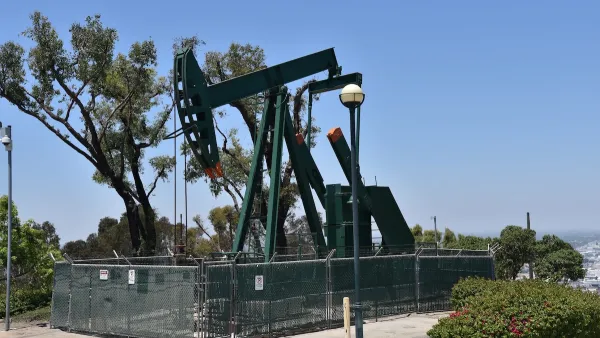The oil-rich county hopes to boost its economy with a revised plan for new drilling after a state court struck down a 2015 ordinance.

Kern County, the center of California's oil industry, is poised to approve a "revised ordinance supported by the influential petroleum industry that creates a blanket environmental impact report to approve as many as 2,700 new wells a year." The 87 revisions were necessary "after a state appeals court ruled last year that a 2015 ordinance violated the California Environmental Quality Act by not fully evaluating or disclosing environmental damage that would occur from drilling," reports Brian Melley in the Los Angeles Times. "New drilling permits were not allowed while the county returned to the drawing board."
The new plan includes "creating larger buffers between homes and wells, muffling noise during drilling and putting a stricter limit on the number of new wells." County officials claim that the limits simply signify a "worst case scenario," as "actual permit numbers in recent years were below the cap." Supporters argue that new wells would "support high-paying jobs and produce oil under some of the most stringent environmental laws, instead of relying on dirtier imports."
Environmental groups expressed concern about the impact new drilling would have on the "notoriously bad air pollution in the San Joaquin Valley." Farmer Keith Gardiner, who opposes the plan, claims it "still falls short of providing protection for valuable agricultural land."
Opponents also disagree with using blanket EIRs to approve multiple wells, saying that "a one-size-fits-all approach didn’t address different factors that varied by location, such as habitat or proximity to neighborhoods." If the revised ordinance passes, groups including the Center on Race, Poverty and the Environment plan to return to court.
FULL STORY: Kern County could permit tens of thousands of new oil wells over the next 15 years

National Parks Layoffs Will Cause Communities to Lose Billions
Thousands of essential park workers were laid off this week, just before the busy spring break season.

Retro-silient?: America’s First “Eco-burb,” The Woodlands Turns 50
A master-planned community north of Houston offers lessons on green infrastructure and resilient design, but falls short of its founder’s lofty affordability and walkability goals.

Delivering for America Plan Will Downgrade Mail Service in at Least 49.5 Percent of Zip Codes
Republican and Democrat lawmakers criticize the plan for its disproportionate negative impact on rural communities.

Test News Post 1
This is a summary

Test News Headline 46
Test for the image on the front page.

Balancing Bombs and Butterflies: How the National Guard Protects a Rare Species
The National Guard at Fort Indiantown Gap uses GIS technology and land management strategies to balance military training with conservation efforts, ensuring the survival of the rare eastern regal fritillary butterfly.
Urban Design for Planners 1: Software Tools
This six-course series explores essential urban design concepts using open source software and equips planners with the tools they need to participate fully in the urban design process.
Planning for Universal Design
Learn the tools for implementing Universal Design in planning regulations.
EMC Planning Group, Inc.
Planetizen
Planetizen
Mpact (formerly Rail~Volution)
Great Falls Development Authority, Inc.
HUDs Office of Policy Development and Research
NYU Wagner Graduate School of Public Service





























